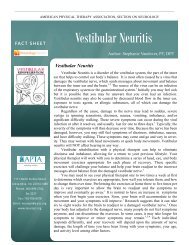Practice Guidelines for BPPV - Neurology Section
Practice Guidelines for BPPV - Neurology Section
Practice Guidelines for BPPV - Neurology Section
Create successful ePaper yourself
Turn your PDF publications into a flip-book with our unique Google optimized e-Paper software.
Vestibular SIG Newsletter <strong>BPPV</strong> Special Edition<br />
<strong>Practice</strong> <strong>Guidelines</strong> <strong>for</strong> <strong>BPPV</strong> as described by the<br />
medical community<br />
Heather Dillon Anderson, PT, DPT, NCS<br />
Neumann University<br />
In 2008 the American Academy of <strong>Neurology</strong> (AAN) as<br />
well as the American Academy of Otolaryngology-Head<br />
and Neck Surgery Foundation (AAO-HNS) published<br />
clinical practice guidelines <strong>for</strong> treating persons with<br />
benign paroxysmal positional vertigo (<strong>BPPV</strong>). In both<br />
cases the guidelines were intended to help standardize<br />
best practice techniques <strong>for</strong> treating <strong>BPPV</strong> and were<br />
based on extensive reviews of the existing literature. The<br />
recommendations were ultimately based on the quality of<br />
the research examined. The AAN did not specify who the<br />
guidelines were intended <strong>for</strong>, but the AAO-HNS<br />
described its audience as being “all clinicians who are<br />
likely to diagnose and manage adults with <strong>BPPV</strong>” and<br />
described the guidelines as being intended to “improve<br />
the quality of care and outcomes <strong>for</strong> <strong>BPPV</strong>.”<br />
(Bhattacharyya et al, 2008) After reviewing the practice<br />
guidelines described by both the AAN and AAO-HNS,<br />
the intent of this article is to summarize the findings and<br />
describe the clinical relevance to practice.<br />
<strong>BPPV</strong> occurs when calcium carbonate crystals,<br />
called otoconia, become dislodged from the structures<br />
that contain them (the utricle and saccule) and create a<br />
current of endolymph within the affected semicircular<br />
canal. Because the otoliths are dense, head movement<br />
causes them to move within the canals and creates<br />
symptoms of vertigo and nystagmus. Typically there are<br />
two types of <strong>BPPV</strong> described: canalithiasis, which occurs<br />
when the otoliths are free floating in the canal and<br />
cupulolithiasis, which occurs when the otoliths adhere to<br />
the gelatinous region (the cupula) within one of the<br />
canals. Canalithiasis is the more common type of <strong>BPPV</strong><br />
and is thought to respond better to treatment because the<br />
otoliths are free floating. Neither practice<br />
guideline specifically described which type of <strong>BPPV</strong> the<br />
research was referring to. <strong>BPPV</strong> may occur in any of the<br />
three semicircular canals of the inner ear: anterior<br />
(superior), posterior and horizontal (lateral). Both<br />
practice guidelines identified posterior canal as being the<br />
most common and anterior the least. Because anterior<br />
canal <strong>BPPV</strong> is least common there was insufficient<br />
evidence found by either review to create guidelines <strong>for</strong><br />
this type of <strong>BPPV</strong>.<br />
<strong>BPPV</strong> has a lifetime prevalence of 2.4% and is<br />
2<br />
described as the most common vestibular disorder in<br />
adults (Bhattacharyya et al, 2008), (Fife et al, 2008).<br />
Furthermore, the recurrence rate <strong>for</strong> <strong>BPPV</strong> is<br />
described as being 10-18% one year after treatment,<br />
37-50% five years after treatment, and an overall<br />
recurrence rate of 15% per year (Bhattacharyya et al,<br />
2008). The age of onset <strong>for</strong> <strong>BPPV</strong> is most common<br />
between the ages of 50 and 70. According to Oghalai<br />
et al, (2000), approximately 9% of elderly patients<br />
undergoing comprehensive geriatric assessment <strong>for</strong><br />
non-balance complains fail to be tested <strong>for</strong> <strong>BPPV</strong>.<br />
Because <strong>BPPV</strong> causes vertigo, many persons with this<br />
condition also have balance impairment and<br />
subsequently may have an increased risk of falling,<br />
especially in the aging population. Proper diagnosis<br />
and treatment of <strong>BPPV</strong> is essential to reduce<br />
symptoms of vertigo and prevent falls, which can lead<br />
to debilitating and costly secondary health<br />
complications.<br />
The first step in adequate management of<br />
<strong>BPPV</strong> is diagnosing the condition. The AAO-HNS<br />
describes the diagnosis of posterior semicircular when<br />
two conditions are present: (1) the patient<br />
reports a history of vertigo associated with changes in<br />
head position and (2) the Dix-Hallpike test provokes<br />
the characteristic nystagmus described <strong>for</strong> this<br />
condition. The nystagmus described <strong>for</strong> posterior<br />
canal <strong>BPPV</strong> is up-beating and torsional with the fast<br />
phase beating toward the side being tested.<br />
To complete the Dix-Hallpike test the patient<br />
is first positioned in a long sitting position, next the<br />
examiner rotates the head 45 degrees and quickly<br />
moves the patient into a supine position with the neck<br />
extended 20 degrees beyond the horizontal plane.<br />
While in this position, the examiner observes the<br />
person’s eyes <strong>for</strong> nystagmus, specifically the duration<br />
and direction. Finally the person is returned to the<br />
long sitting position and the other side is tested. The<br />
research completed by the AAO-HNS confirmed that<br />
the Dix-Hallpike test continues to be the “gold<br />
standard” <strong>for</strong> diagnosing posterior canal <strong>BPPV</strong>; with a<br />
“strong recommendation” <strong>for</strong> use described. However<br />
this evidence was described as being Grade B, which<br />
indicates that there were minor limitations in the<br />
studies examined. (For definitions of the Grade levels<br />
of evidence refer to the table at the end of the article.)

















